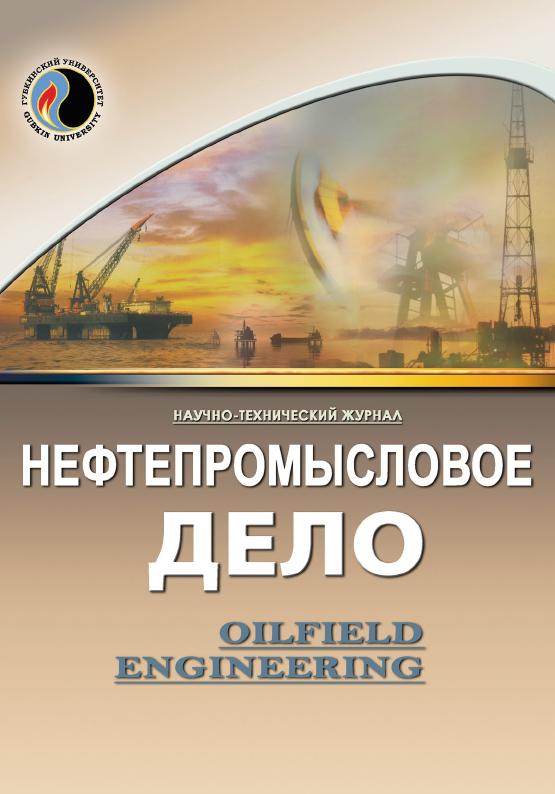Determination of fault tectonics influence on the horizontal wells productivity
UDC: 622.276.1/.4(571.1)
DOI: 10.33285/0207-2351-2023-6(654)-59-66
Authors:
KRIVOVA NADEZHDA R. 1
1,
ISKHAKOVA GALIYA R.1
1 Industrial University of Tyumen (branch in Nizhnevartovsk), Nizhnevartovsk, Russia
Keywords: horizontal well drilling, fault network, well flow rates, hard-to-recover reserves
Annotation:
The current relevant objective of developing hard-to-recover reserves can be solved using a systematic approach to the development of low-permeability reservoirs. The article considers the experience of operating horizontal wells drilled with different azimuth directions. The optimal direction of horizontal wellbores has been determined and it has been revealed that the productivity of wells drilled along the main fault network is higher.
Bibliography:
1. Issledovanie optimal'nogo raspolozheniya gorizontal'nykh skvazhin s MGRP otnositel'no regional'nogo stressa s primeneniem tekhnologii dinamicheskogo markernogo monitoringa
/ D.A. Shestakov, I.G. Badrtdinov, M.M. Galiev [i dr.] // Neftegazovaya vertikal' – 2021. – № 21. – S. 86–96.
2. Povyshenie effektivnosti razrabotki nizkopronitsaemykh kollektorov mestorozhdeniy Zapadnoy Sibiri sistemoy gorizontal'nykh skvazhin / N.R. Krivova, D.S. Reshetnikova, K.V. Fedorova, S.V. Kolesnik // Geologiya, geofizika i razrabotka neftyanykh i gazovykh mestorozhdeniy. – 2015. – № 5. – S. 54–58.
3. Severo-Khokhryakovskoe neftyanoe mestorozhdenie // Neftegaz.RU. – 2022. – URL: https://neftegaz.ru/tech-library/mestorozhdeniya/142396-severo-khokhryakovskoe-neftyanoe-mestorozhde... (data obrashcheniya: 30.11.2022).
4. Krygina E.I. Geologicheskie osobennosti plasta YuV1 na Severo-Khokhryakovskom mestorozhdenii // Akademicheskiy zhurnal Zapadnoy Sibiri. – 2016. – № 5(66). – S. 26.
5. Yaskevich S.V., Duchkov A.A., Andersson F. Mikroseysmicheskiy monitoring v azimutal'no anizotropnykh sredakh. Tochnost' lokatsii i vozmozhnost' opredeleniya parametrov anizotropii
// Interekspo GEO-Sibir', 2013: IX Mezhdunar. nauch. kongr., Novosibirsk, 15–26 apr. 2013; Nedropol'zovanie. Gornoe delo. Novye napravleniya i tekhnologii poiska, razvedki i razrabotki mestorozhdeniy poleznykh iskopaemykh. Geoekologiya: sb. mater. v 3-kh t. – T. 2 – S. 9–13.
6. Quantitative prediction of the drilling azimuth of horizontal wells in fractured tight sandstone based on reservoir geomechanics in the Ordos Basin, Sentral China / Jingshou Liu [et al.] // Marine and Petroleum Geology. – 2021. – Vol. 136(3). –
P. 105439. – DOI: 10.1016/j.marpetgeo.2021.105439
7. Mikroseysmicheskiy monitoring treshchin mnogostadiynogo GRP dlya optimizatsii formiruemoy sistemy razrabotki mestorozhdeniya / M.A. Romanchev, D.G. Chernykh, A.I. Kirillov [i dr.] // Tekhnicheskie publikatsii Schlumberger. – 2013.
8. Kaiser E.J. A Study of Acoustic Phenomena in Tensile Test. Doctor’s thesis. Technical University of Munich, Munich, Germany: Technical University of Munich, Munich, 1950. –
Pp. 1–38.
9. Marrett R., Ortega O.J., Kelsey C.M. Extent of power-law scaling for natural fractures in rock // Geology. – 1999. –
Vol. 27(9). – P. 799–802.
10. Olson J.E., Laubach S.E., Lander R.H., Natural fracture characterization in tight gas sandstones: integrating mechanics and diagenesis // Am. Assoc. Pet. Geol. Bull. – 2009. –
Vol. 93(11). – P. 1535–1549.
11. Lakirouhani A., Detournay E., Bunger A.P. A reassessment of in situ stress determination by hydraulic fracturing // Geophysical J. International. – 2016. – Vol. 205(3). – P. 1859–1873.
12. Li Y.X., Xiao S.M. Relationship between reservoir in situ and fractured fractures (in Chinese with English abstract) // Special Oil Gas Reservoirs. – 2000. – Vol. 7 (3). – P. 33–35.
13. Petrushkin E.O., Arutonyan A.S. Opredelenie vliyaniya geologicheskikh i tekhnologicheskikh faktorov na proizvoditel'nost' gorizontal'nykh skvazhin na primere morskogo neftyanogo mestorozhdeniya Kvartsevoe D-6 // Nauka, tekhnika, tekhnologii. – 2015. – № 3. – S. 81–89.

